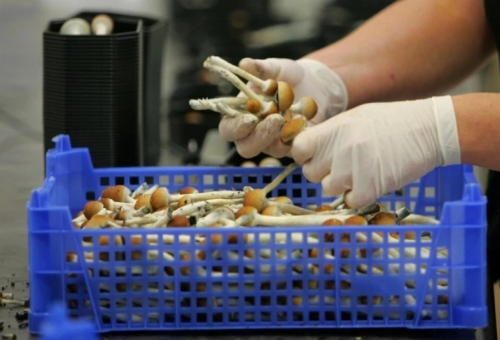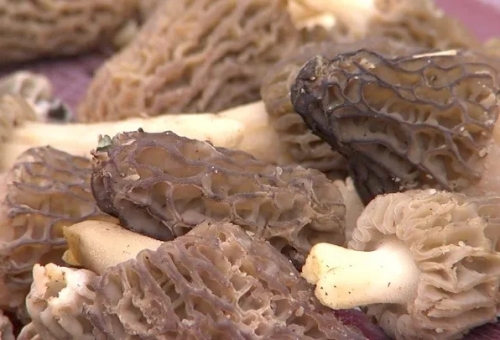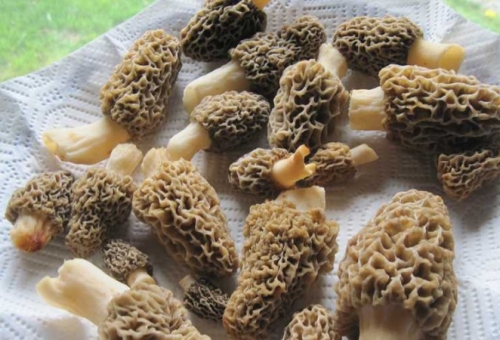"I roast it whole, or I dry it," Spacht adds, adding maitakes are said to have cancer-fighting and other medicinal properties.
Spacht says he has made a vegan version of cheese steak, using a slab of cooked maitake and cashew cheese.
Chanterelle mushrooms can be found in July, Snyder says.
"They look like a little flower. They're bright yellow-orange. And they're unique in that they have a fruity quality. They look and smell like apricots."
Snyder says he sautés his chanterelles, which can be served with pasta, chicken, rice or fish, and which liven up dishes with their color.
Spacht also likes a type of chanterelle called the black trumpet.
"It adds a smoky, buttery flavor to whatever you add it to," Spacht says. "They're a hauntingly somber mushroom. … They're very delicate."
Snyder likes cooking with blewit mushrooms, which are harvested in late fall and early winter.
"It's about the size of a tennis ball, and it has violet-colored gills," Snyder says. "I think it has an anise quality to it," which he likes to bring out by cooking it with Pernod liqueur, tarragon or fennel.
Several types of mushroom have a fishy taste, Spacht says, including the lion's mane, which looks like a white beard, and the pom pom, which resembles a big white ball and has the texture of shrimp.
Spacht suggests serving them with tartar or cocktail sauce, as you would shrimp.
Those mushrooms, and some other fishy-tasting ones given the Latin family name "lactarius" because of a milky substance they secrete, lend themselves well to fish dishes, Snyder says.
While some of these unusual mushrooms can be hard to find in stores in Lancaster County, Poppiti suggests they may become more readily available once consumers learn about them and start requesting them in stores.
"It's definitely helped, with the foodie culture that's been growing," says Katie Preis, marketing coordinator for the Mushroom Council. "People are more willing to experiment with different mushrooms."
Foragers invite the public
Chris Snyder says Eastern Pennsylvania Mushroomers forage for a variety of mushrooms from April through December, and that he and other members get together to share mushroom dishes at a tasting event in late June.
Snyder cautions that no one should eat any kind of wild mushroom unless they're sure it's safe to consume.
"I cannot stress enough how careful you have to be," Snyder says. He notes there are mushrooms that grow commonly in Lancaster County — even on people's lawns — that are extremely poisonous.
Mushroom club members are happy to help people identify mushrooms, and give them advice about cooking them.
For information on foraging trips, most of which take place within an hour's drive of Lancaster, Snyder notes, visit the club's website, epennmushroomers.org.
"All of our forays are open to the public except for morel forays," Snyder says. Morels are "very much sought after by people that generally wouldn't go mushroom hunting. So those are for members only."
Snyder notes the club's first open foraging trip of 2013 is set for June 23 in Wagontown, Chester County.
For more information on mushroom varieties, nutrition and uses in cooking, visit the Mushroom Council's website at mushroominfo.com.
And for those who want to immerse themselves in the fabulous fungi produced in Chester County, visit the Kennett Square Mushroom Festival the weekend of Sept. 7 and 8. Visit mushroomfestival.org for more information.
Advice for drying and freezing
Fans of exotic mushrooms like to forage for them throughout the year, and cook them while they're fresh.
But some mushrooms also lend themselves to drying and freezing.
Chris Snyder, of the Eastern Pennsylvania Mushroomers, says he likes to dry his morel mushrooms in a food dehydrator.
"You don't have to wash it or anything," Snyder says. "Dry it for a couple of hours at 90 degrees, and then I would up my temperature to about 125 degrees and dry them for another four, five hours.
"And they're well-preserved at that point," Snyder adds, "and any dirt on them just falls off. You do rinse them when you reconstitute them, briefly."
To reconstitute morels, Snyder says, "we cover them with water in a pan, and I just bring it up to a simmer, and then I just turn the heat off. Let it sit for about five minutes.
"The drying magnifies the flavor," Snyder says, "and then you can use them all year long."
Snyder says he freezes maitake mushrooms after blanching them for about five minutes.
He also freezes chanterelles, which he says don't seem to lend themselves well to drying because they can develop a metallic taste. Snyder says he sautés those in butter before freezing them.
Casey Spacht, an organic farmer and mushroom forager, says he also dries the black trumpet variety of chanterelle mushroom, so he can later add a few of them to soups or stews.
























